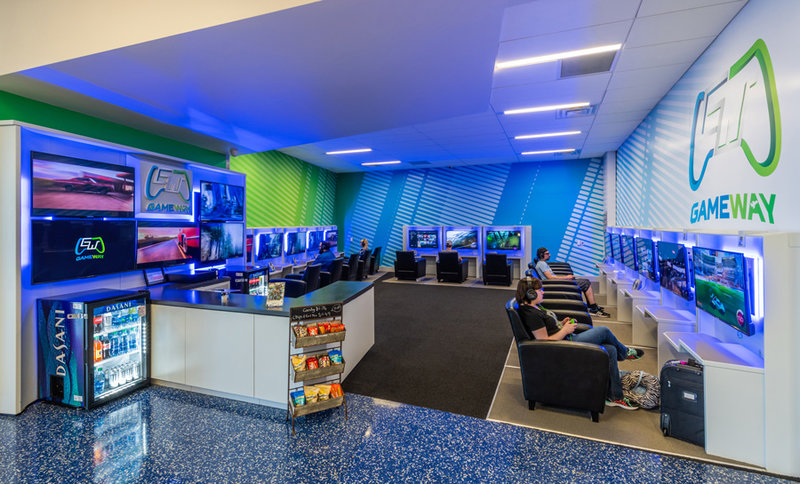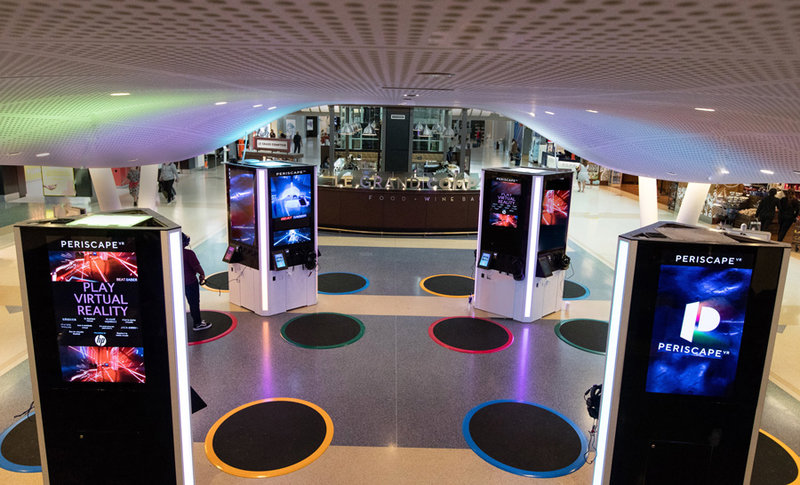
Technology
Game on:
Are video games the future of passenger entertainment?
The video games industry is massive, and the appeal of interactive entertainment now spans a wider demographic than ever before. Joe Baker looks at the pros and pratfalls of merging this exciting medium with the aviation sector
With ancillary revenues becoming more important, airports and airlines are facing pressure to boost their engagement with passengers in increasingly innovative ways.
In this respect, video games could present an enticing opportunity for the aviation sector. According to research by analysts Newzoo, the video games industry as a whole was worth $135bn in 2018 – a growth of 10.9% from 2017 - while the Entertainment Software Association relays that at least 75% of Americans have at least one gamer in their household.
Airports such as Singapore Changi and Paris-Charles de Gaulle have introduced dedicated gaming spaces featuring retro games and gaming merchandise. Last year, Texas’s Dallas Fort Worth (DFW), the second largest airport in US, reportedly became the first aviation hub in the country to offer a premium gaming lounge. Meanwhile, airlines are increasingly including games in some form as part of their in-flight entertainment (IFE) offering, with Emirates providing more than 100 to sift through on its long-haul flights.
However, despite climbing demand for gaming, the growing expectations of high-quality content and inevitable financial and logistical challenges make it a more difficult decision to invest. Could the introduction of more video game content press start on a new era of passenger entertainment, or will it all be a waste of lives?
Caption.
Image courtesy of
Exploring GameWay: a premium gaming lounge for airports
Airports have featured arcades in all shapes and sizes for decades, but GameWay co-founders Jordan and Emma Walbridge wanted their lounges to be something entirely different. The bespoke gaming rooms installed at DFW are light, airy spaces containing 36 gaming stations equipped with PlayStation 4 Pro consoles, as well as lounge chairs, 4K TVs and noise cancelling headphones. Customers can pay to enter the lounge and play games over a number of time periods (e.g. $19.99 for one hour or $34.99 for two hours), allowing them to grab a controller whether they are expecting a short stopover or a lengthy delay.
“People who are leading the airports really have to have an eye towards what the future looks like,” says Jordan Walbridge. “Often when they think video games they think about Atari or arcade-style situations, so we bring something completely different.”

Image courtesy of GameWay
Although he doesn’t delve too far into GameWay’s financial arrangement with DFW, Walbridge says that the airport has seen a significant retail sales increase in shops surrounding the lounges, as well as a boost to engagement on social media. “Within six months of us being there, [DFW has] already been looking at how GameWay can expand, so financially this thing has made a lot of sense for the airport,” says Walbridge. “I can't tell you how many times someone would tweet out or put on social media that their flight was delayed, but thank God GameWay is there because now they have something to do.”
Unsurprisingly, airports looking to install a gaming utopia have to think beyond the standard ‘VIP’ amenities found in premium departure lounge. In addition to hardware, a solid connectivity infrastructure is also necessary; Walbridge says that the lounges required a dedicated internet connection with upload/download speeds of around 300mb a second. Then there is the cost and process of licensing the games - in GameWay’s case, around 20 of them – and allaying concerns about whether games are appropriate for the general audience.
Walbridge says that the company’s aim is to consolidate solutions to these challenges and experience from DFW into a package that can be offered up to other airports. The company has already been in talks with other aviation hubs in the US, and Walbridge hopes global enthusiasm for video games will spur more interest from airports in Europe and beyond.
People who are leading the airports really have to have an eye towards what the future looks like
Levelling up: airports boosting their appeal to passengers
GameWay evolved from the fact that many airports are busy but still quite boring places to be. It’s a sentiment that makes sense, given airports operate in a variety of sizes and business models, but at the end of the day the priorities have often the same; generating revenue and keeping passengers moving. Making airports an entertainment destination – think along the lines of Singapore’s Changi airport – has not been a viable investment across America’s smorgasbord of regional, commuter and international airports, for example.

Image courtesy of GameWay
“A lot of airports are concerned about doing something really new, giving up valuable real estate to do something completely different,” says Walbridge. “In America they are trying to change the narrative from an airport being like a bus stop where you only get there to leave, to going there and having an experience you're going to remember at that airport.”
Indeed, recent studies have suggested that a greater focus on customer experience is yielding better satisfaction scores at airports. A report from Airport Council International found that global passenger satisfaction levels in Q3 2018 increased to 4.21 – an increase from 4.17 for the same period a year before.
Gaming in particular also taps into a broader trend of technology being used to engage with passengers at airports. In 2018, virtual reality (VR) start-up Periscape VR opened a new recreational area at New York’s John F Kennedy airport, which featured a dozen 6ft free-standing podiums known as VR Towers. Customers can strap on a headset and participate in a number of VR games and experiences (infamous iOS app ‘Fruit Ninja’ is amongst them), while the VR Towers can also be used for visual marketing purposes.

Image courtesy of Periscape VR
“Millennials represent 30% of retail shoppers,” says Periscape VR CEO and Founder Lynn Rosenthal. “When this generation is considering a purchase, they value experiences much more than buying merchandise. Eight in ten millennials say their best memories are from an event or live experience.”
“Passengers love virtual reality. We all know, happy travellers like to shop more! Many airports view this as an opportunity for ticketing, advertising and additional merchandising revenue streams.”
A lot of airports are giving up valuable real estate to do something completely different
Gaming in the skies
When it comes to airlines’ servicing long-haul intercontinental flights, IFE options have improved dramatically in recent years. Passengers may now opt to choose one airline over another because of what they could be watching, listening to, or playing as they soar through the skies.
Major IFE content producer Global Eagle is one example of a company to profit from this captive market. The company now owns the rights to more than 120 games installed in the seats of more than 100 airlines. According to a statement made last year by Global Eagle CEO Per Norén, the company’s games are currently being played more than 150 million times annually by passengers.
Recently, Panasonic Avionics Corporation partnered with two leading games companies – Gameloft and Toca Boca – to add a new ‘Gaming’ section to its Theatre IFE solution. The aim, according to a press release, it to appeal to a ‘new segment of passengers that are interested in new digital experiences’, while offering ‘a better cost-to-value ratio than traditional media’.
“For airlines, these innovative solutions provide a game-changing way to differentiate themselves in the market, and a unique way to drive ancillary revenue generation,” said Panasonic vice-president of product management and marketing Gaston Sandoval.

However, ultimately the financial aspects of inflight gaming and limitations of current hardware means there is a limit on scope compared to what can be achieved on the ground. Current console retail prices hover at around $200, and airlines have to weigh up space requirements against the option of installing consoles complete with controllers, HDMI-capable television screens and headsets.
In addition, the portability of gaming has had a substantial impact on the types of experiences gamers want to play. According to Newzoo, the mobile games market in particular grew at an accelerated rate of 12.8% in 2018 due to the high adoption of smartphones. Then there’s Nintendo’s portable switch console, which allows players to play console-quality games anywhere. Facilitating the use of these devices (i.e. through USB chargers) might be more viable for airlines than forking out for bespoke passenger entertainment systems.
One area which might have some traction is e-sports – competitive video games being broadcast over a video stream. Although not all gamers get the same thrill from watching others play their favourite games, gaining access to e-sports content would allow airlines to meet the demands of avid fans with current IFE technology. Indeed, Emirates made waves in 2017 when it signed a deal to showcase major gaming moments from the Electronic Sports League – a major e-sports provider – across its global flight network.
Whether an airline or airport would ever take the bold step of making gaming a USP remains to be seen. What stakeholders should recognise, however, is that video games are far from being a niche pursuit, and finding unique ways to facilitate a more tech-savvy audience could yield major dividends in the future.
“Companies need to future-proof today,” says Rosenthal. “Those who don’t will be left behind.”
For airlines, these innovative solutions provide a game-changing way to differentiate themselves in the market.